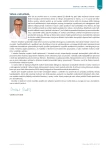A strategy for cardiovascular prevention: that’s what matters!
Authors:
Michal Vrablík
Authors‘ workplace:
Centrum preventivní kardiologie, III. interní klinika – klinika endokrinologie a metabolismu 1. LF UK a VFN v Praze
Published in:
AtheroRev 2019; 4(3): 185-188
Category:
Nová pravidla pro management dyslipidemií zveřejněná v září 2019 přinesla nové paradigma pro kardiovaskulární prevenci, které lze shrnout do principu „čím dříve níže, tím lépe“. Již delší dobu víme, že pro manifestaci velké aterosklerotické cévní komplikace musí být cévní stěna vystavena tzv. kumulativní zátěži LDL-cholesterolem (LDL-C) ve výši 150 mmol/l. Určujeme ji jako průměrnou roční koncentraci LDL-C násobenou počtem let, po která působí. Dosavadní přístup je příliš konzervativní a lze konstatovat, že „lipidovou“ intervenci si zaslouží prakticky každý nemocný s vyšším krevním tlakem. Nicméně odstup mezi diagnózou arteriální hypertenze a dyslipidemie stále zůstává téměř 10 let. Pro úspěšnost preventivní intervence je mimo jiné důležitá adherence pacienta, kterou lze ovlivnit volbou osvědčených léčiv s dobrým bezpečnostním profilem. Mezi taková léčiva patří fixní kombinace. V prevenci kardiovaskulárních nemocnění zapříčiněných aterosklerózou je to kombinace atorvastatinu s perindoprilem – přípravek Euvascor®, který nabízí více fixních kombinací umožňujících titraci dávky perindoprilu k maximu.
Overview
The new guidelines for the management of dyslipidemia published in September 2019 brought a new paradigm for cardiovascular prevention, which can be summarized in the principle "the sooner the lower, the better". We have known for a long time that manifestation of a major atherosclerotic vascular complication, underlies exposition of the vascular wall to a so-called cumulative burden of LDL-C (LDL-C) of 150 mmol/L. This could be determined as the average annual concentration of LDL-C multiplied by the number of years it acts. The current approach may be too conservative for some patients and it can be stated that practically every patient with other risk factors deserves a "lipid" intervention. The most common of these is undoubtedly arterial hypertension. However, the gap between the diagnosis of arterial hypertension and dyslipidemia remains nearly 10 years. Patient adherence is also important for the success of preventive intervention, which can be influenced by the selection of proven drugs with a good safety profile. One of the proven and simple ways to improve adherence is the choice of fixed combinations. A fixed combination of atorvastatin with perindopril (Euvascor®), the two most common active substances in the treatment of dyslipidemia and hypertension, has recently entered clinical practice. It will certainly be widely used as initial treatment as well as in more complex combination regimens.
Received 24. 9. 2019
Keywords:
combination therapy – Atherosclerosis – atorvastatine – cardiovascular risk – dyslipidemia – hypertension – LDL-cholesterol
Sources
- Knuuti J, Winjs W, Saraste A et al. 2019 ESC guidelines on the diagnosis and management of chronic coronary syndromes. Eur Heart J 2019; pii: ehz425. Dostupné z DOI: <http://dx.doi.org/10.1093/eurhearj/ehz425>.
- Mach F, Baigent C, Catapano AL et al. 2019 ESC/EAS guidelines for the management of dyslipidaemias: lipid modification to reduce cardiovascular risk. Eur Heart J 2019; pii: ehz455. Dostupné z DOI:<http://dx.doi.org/10.1093/eurheartj/ehz455>.
- Cosentino F, Grant PJ, Aboyans V et al. 2019 ESC guidelines on diabetes, pre-diabetes and cardiovascular diseasesEur Heart J 2019; pii: ehz486. Dostupné z DOI: <http://dx.doi.org/10.1093/eurheartj/ehz486>.
- Vrablík M, Piťha J, Blaha V et al (za výbor ČSAT). Stanovisko výboru České společnosti pro aterosklerózu k doporučením ESC/EAS pro diagnostiku a léčbu dyslipidemií z roku 2019. Atheroreview 2019; 4(3): XXX-XXX.
- Vrablík M. Současné a budoucí trendy v léčbě dyslipidemií. Vnitr Lek 2019; 65(10). V tisku.
- Gidding SS, Rana JS, Prendergast C et al. Pathobiological Determinants of Atherosclerosis in Youth (PDAY) Risk Score in Young Adults Predicts Coronary Artery and Abdominal Aorta Calcium in Middle Age: The CARDIA Study. Circulation 2016; 133(2): 139–146. Dostupné z DOI: <http://dx.doi.org/10.1161/CIRCULATIONAHA.115.018042>.
- Borén J, Williams KJ. The central role of arterial retention of cholesterol-rich apolipoprotein-B-containing lipoproteins in the pathogenesis of atherosclerosis: a triumph of simplicity. Curr Opin Lipidol 2016; 27(5): 473–483. Dostupné z DOI: <http://dx.doi.org/10.1097/MOL.0000000000000330>.
- Nordestgaard BG, Chapman MJ, Humphries SE et al. Familial hypercholesterolaemia is underdiagnosed and undertreated in the general population: guidance for clinicians to prevent coronary heart disease: consensus statement of the European Atherosclerosis Society. Eur Heart J 2013; 34(45): 3478–3490a. Dostupné z DOI: <http://dx.doi.org/10.1093/eurheartj/eht273>.
- Chmelík Z, Vrablík M, Vaclová M et al. Vysoká prevalence kardiovaskulárních rizikových faktorů a neuspokojivá kontrola hladin LDL-cholesterolu v populaci 40letých mužů a 50letých žen v České republice. AtheroRev 2016; 1(3): 111–115.
- Emberson J, Whincup P, Morris R et al. Evaluating the impact of population and high-risk strategies for the primary prevention of cardiovascular disease. Eur Heart J 2004; 25(6): 484–491. Dostupné z DOI: <http://dx.doi.org/10.1016/j.ehj.2003.11.012>.
- Chapman RH, Benner JS, Petrilla AA et al. Predictors of adherence with antihypertensive and lipid-lowering therapy. Arch Intern Med 2005; 165(10): 1147–1152. Dostupné z DOI: <http://dx.doi.org/10.1001/archinte.165.10.1147>.
- Borén J, Williams KJ. The central role of arterial retention of cholesterol-rich apolipoprotein-B-containing lipoproteins in the pathogenesis of atherosclerosis: a triumph of simplicity. Curr Opin Lipidol 2016; 27(5): 473–483. Dostupné z DOI: <http://dx.doi.org/10.1097/MOL.0000000000000330>.
Labels
Angiology Diabetology Internal medicine Cardiology General practitioner for adultsArticle was published in
Athero Review

2019 Issue 3
Most read in this issue
- Ten ways of using ezetimibe, or a brief guide to its use today
- A statement of the Committee of the Czech Society for Atherosclerosis on the 2019 ESC/EAS Recommendations for the diagnosis and treatment of dyslipidemia
- Specificities of the treatment for vascular system diseases in patients with a chronic renal disease
- Dyslipidemia in patients with chronic kidney disease
